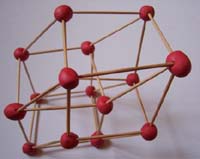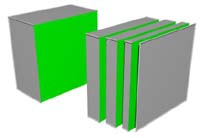Why do we need eight cubes for a net of a hypercube?
To understand it, let us examine the cases of a square and a cube:
- For a square each edge is adjacent to other two. The two vertices of these two edges, which are not in common with the original one, are the vertices of the edge opposite to the original one. The number of the edges is thus 1+2+1=4 (the first one, the two adjacent ones and the opposite one);
- For a cube each square is adjacent to other four squares (it has four edges); the “free” edges of these four squares are the edges of the square opposite to the original one. The number of the faces is thus 1+4+1=6 (the original face, the four adjacent ones and the opposite one).
Both in the case of a square and a cube, we have the following situation: each ”face” (an
edge or a square respectively) is adjacent to “almost” all the other faces, that is all except one of them.
 Let us try to proceed by analogy for a hypercube. Since each “face” of a hypercube is a cube, with six faces, it is reasonable to think that there are 1+6+1=8 cubic faces of a hypercube (a cube, the six adjacent cubes and the opposite cube). We are led to assume that a hypercube has eight cubic faces.
Let us try to proceed by analogy for a hypercube. Since each “face” of a hypercube is a cube, with six faces, it is reasonable to think that there are 1+6+1=8 cubic faces of a hypercube (a cube, the six adjacent cubes and the opposite cube). We are led to assume that a hypercube has eight cubic faces.How many cubes are there really in a hypercube? Infinitely many!
To understand this statement, let us consider again a cube and proceed by analogy.
 A cube has six faces, which are identical. Actually, there are infinitely many squares in a cube. For example, let us consider a cube and a plane parallel to a face. If we imagine to let the cube pass through the plane, the intersection of the plane and the cube is a square at every time.
A cube has six faces, which are identical. Actually, there are infinitely many squares in a cube. For example, let us consider a cube and a plane parallel to a face. If we imagine to let the cube pass through the plane, the intersection of the plane and the cube is a square at every time.
MANCA UN PEZZO!!!
Allo stesso modo immaginate un ipercubo che attraversi un universo tridimensionale come il
nostro, che sia parallelo a una delle sue otto facce cubiche: l’intersezione
dell’universo 3d e dell’ipercubo è un cubo e quindi ad ogni istante apparirebbe come un cubo.
A cura di Paolo Bellingeri per la mostra Un tuffo nella quarta dimensione.